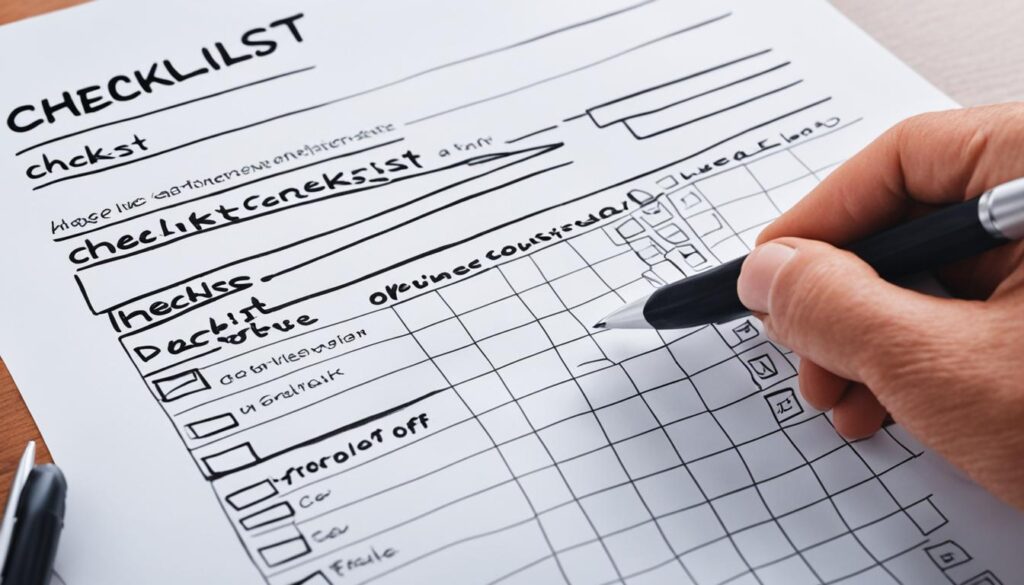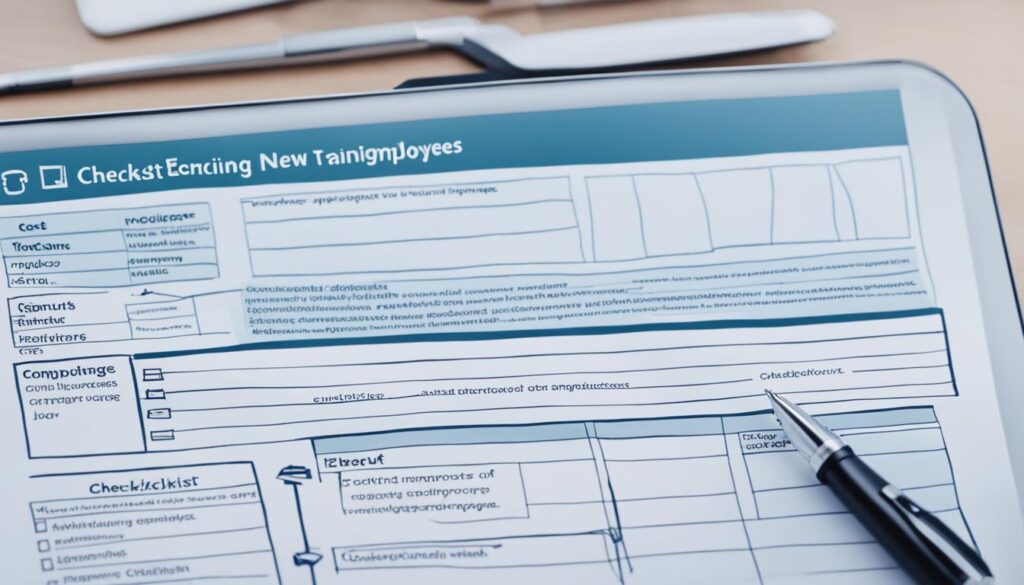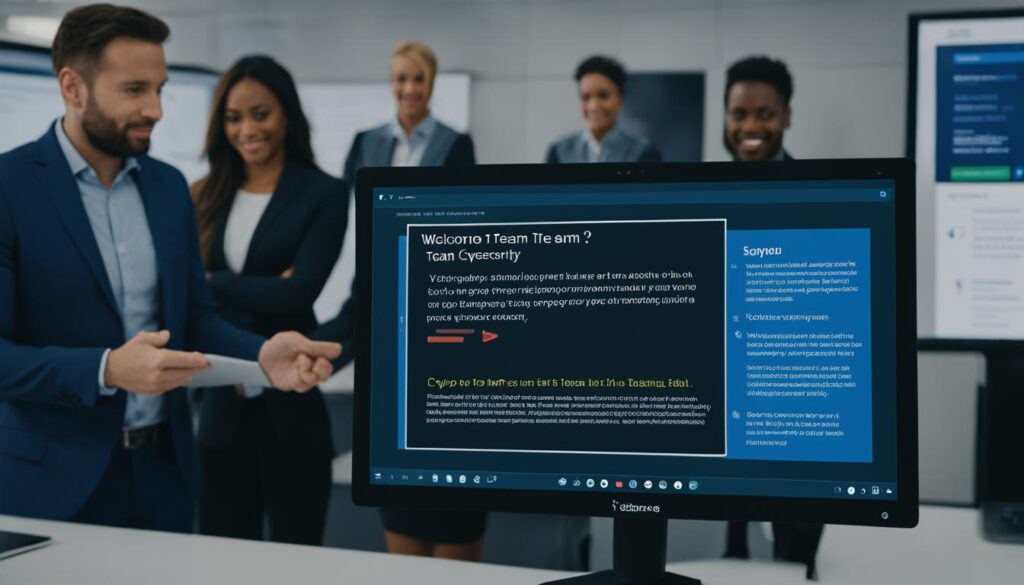The new employee onboarding process is a critical stage for any organization. It sets the tone for the employee’s journey and can greatly impact their long-term success and satisfaction. To ensure a smooth and effective onboarding experience, it is essential to have a comprehensive onboarding checklist in place. This checklist serves as a guide for new employees, outlining the necessary tasks, resources, and information they need to navigate their early days, weeks, and months with the company.
An onboarding checklist can cover various aspects, such as completing background investigations, returning necessary forms, and accessing training materials. It can also include important websites and resources for federal benefits, health and life insurance, retirement planning, and more. By following this checklist, companies can streamline the onboarding process, ease the transition for new employees, and set them up for success from day one.
Key Takeaways:
- An onboarding checklist is an essential tool for a successful new employee onboarding process.
- It provides a comprehensive list of tasks and resources new employees need to complete and access during their initial period with the company.
- The checklist covers important steps like completing background investigations, returning necessary forms, and accessing training materials.
- It also includes key websites and resources for federal benefits, health and life insurance, retirement planning, and more.
- By following the onboarding checklist, companies can guide new employees through the onboarding process effectively and help them acclimate to the organization efficiently.
Benefits of Using an Onboarding Checklist
Using an onboarding checklist offers numerous benefits for both new employees and the organization. This structured approach ensures that all essential tasks and paperwork are completed promptly, minimizing the risk of overlooking crucial steps. With a comprehensive checklist, new employees feel more supported and informed, as they have clear guidelines and expectations from the start.
The onboarding checklist serves as a centralized source of information, providing easy access to relevant resources, websites, and training materials. This enables new employees to quickly familiarize themselves with the organization’s systems and processes, allowing for a smoother transition into their role. By streamlining the onboarding process, the checklist improves efficiency and enhances the overall experience for the new employee.
Furthermore, an onboarding checklist contributes to the successful integration of new employees within the company. It helps to establish a positive company culture, promotes compliance with policies and procedures, and ensures consistent onboarding across different departments. By following the checklist, new employees can navigate their onboarding journey with confidence and gain a sense of belonging within the organization.
Overall, incorporating an onboarding checklist into the employee orientation process is a valuable practice. It not only saves time and reduces administrative errors but also fosters a welcoming environment for new team members, setting the stage for long-term success and engagement.

Components of an Effective Onboarding Checklist
An effective onboarding checklist plays a crucial role in ensuring a seamless integration of new employees into an organization. By covering various aspects of the onboarding process, it helps streamline the transition and sets the foundation for a successful working relationship. Here are the key components that should be included in an onboarding checklist:
- Pre-First Day Tasks: Before the new employee’s first day, there are essential tasks that need to be completed. This may include background investigations, filling out necessary forms, and ensuring all required documents are in order.
- First Day Activities: On the first day, it is important to make the new employee feel welcome and provide them with the information they need to start off strong. Orientation sessions, introductions to team members, and familiarization with the office space are typical tasks to include.
- First Week Focus: During the first week, the onboarding checklist should emphasize policy reviews, goal-setting discussions, and getting acquainted with the company’s systems and resources. This is the time for the new employee to understand the organization’s expectations and start building relationships with colleagues.
- First Month Milestones: In the first month, the new employee should continue to engage with the onboarding process. This may involve completing required trainings, meeting with HR representatives, and establishing regular check-ins with their managers to set expectations and provide guidance.
It is important to remember that each organization has its own unique needs and processes. Therefore, the onboarding checklist should be customizable to fit the specific requirements of your company. By considering these components and tailoring the checklist accordingly, you can ensure a smooth and comprehensive onboarding experience for new hires.

Tips for Creating an Onboarding Checklist
When it comes to creating an effective onboarding checklist, it’s crucial to consider the unique needs and culture of your organization. By mapping out the employee onboarding process from start to finish, you can identify all the necessary steps and resources required for a successful onboarding experience.
1. Comprehensive and Organized Structure
Ensure that your checklist covers all the essential components of the employee onboarding process. Include both transactional tasks, such as completing paperwork and setting up access to company systems, as well as strategic components like goal-setting and career development discussions.
2. Clear Instructions and Explanations
Provide clear instructions and explanations for each task on the checklist. Make sure new employees understand the purpose of each task and how to complete them. This will eliminate any confusion or doubts, making the onboarding process smoother and more efficient.
3. Regular Review and Updates
Regularly review and update your checklist to reflect any changes or improvements to the onboarding process. This ensures that your checklist remains up-to-date with the evolving needs of the organization and helps you maintain a consistent onboarding experience for all new employees.
4. Customization to Fit Your Organization
Customize the checklist to align with your organization’s specific needs, processes, and company culture. Take into account any industry-specific or role-specific requirements to create a checklist that is tailored to the unique onboarding experience of your new employees.
By following these tips and creating a comprehensive and organized onboarding checklist, you can ensure a consistent and positive onboarding experience for all new employees. This not only helps new employees transition into their roles more smoothly but also sets the stage for long-term employee satisfaction and engagement.
Conclusion
An effective onboarding process is crucial for welcoming new employees into your organization and setting them up for success. By implementing employee onboarding best practices and utilizing a comprehensive new employee orientation checklist, you can ensure that all necessary tasks, resources, and information are provided in a structured and organized manner. This not only helps new employees feel supported and informed, but also improves efficiency and productivity throughout the onboarding process.
By following best practices, such as setting clear objectives and goals, providing thorough training, and fostering a welcoming and inclusive environment, you can create a positive onboarding experience that sets the stage for long-term employee satisfaction and engagement.
Customizing the onboarding checklist to fit your organization’s unique needs and processes is essential. Remember to regularly review and update the checklist to reflect any changes or improvements to the onboarding process. By doing so, you can ensure that your onboarding process remains efficient, up-to-date, and in line with your company’s values and culture.
FAQ
What is a new employee onboarding checklist?
A new employee onboarding checklist is a comprehensive list of tasks and resources that new employees need to complete and access during their first few days, weeks, and months with the company. It helps streamline the onboarding process and ensures a smooth start for new team members.
What are the benefits of using an onboarding checklist?
Using an onboarding checklist ensures that all necessary tasks and paperwork are completed in a timely manner, reducing the risk of missing important steps. It also helps new employees feel supported and informed by providing clear guidance on what to expect and what is expected of them. The checklist serves as a centralized source of information, providing access to resources, websites, and training materials relevant to the onboarding process and the employee’s role within the company.
What are the components of an effective onboarding checklist?
An effective onboarding checklist should cover various aspects of the new employee’s integration into the organization. It should include tasks to be completed before the first day, on the first day, in the first week, and within the first month. These tasks may include completing background investigations, attending orientation sessions, meeting team members, reviewing policies, setting goals, completing required trainings, and establishing regular check-ins with managers.
What are some tips for creating an onboarding checklist?
When creating an onboarding checklist, it’s important to consider the unique needs and culture of your organization. Map out the onboarding process from start to finish, identifying necessary steps and resources. Include both transactional tasks and more strategic components, provide clear instructions and explanations, and regularly review and update the checklist to reflect any changes or improvements.
Why is an effective onboarding process important?
An effective onboarding process is crucial for welcoming new employees into the organization and setting them up for success. By using a comprehensive onboarding checklist, companies can ensure that all necessary tasks, resources, and information are provided in a structured manner. This helps new employees feel supported and informed while improving efficiency and productivity.




